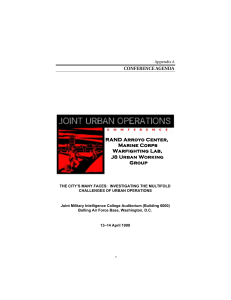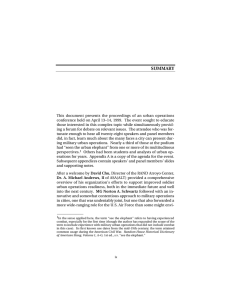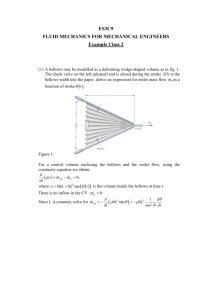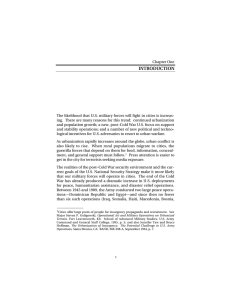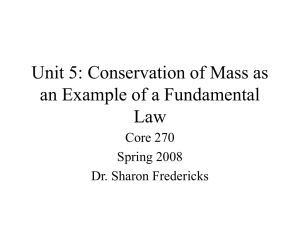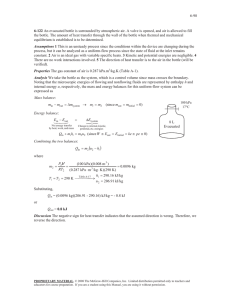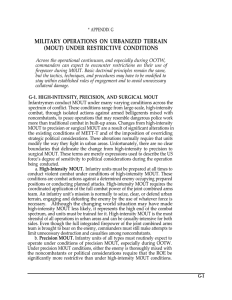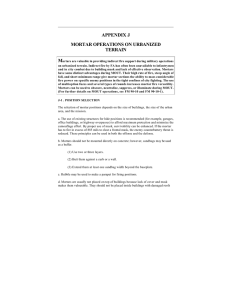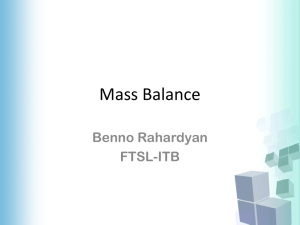JOINT MOUT Mission Area Analysis and Mission Need Assessment
advertisement
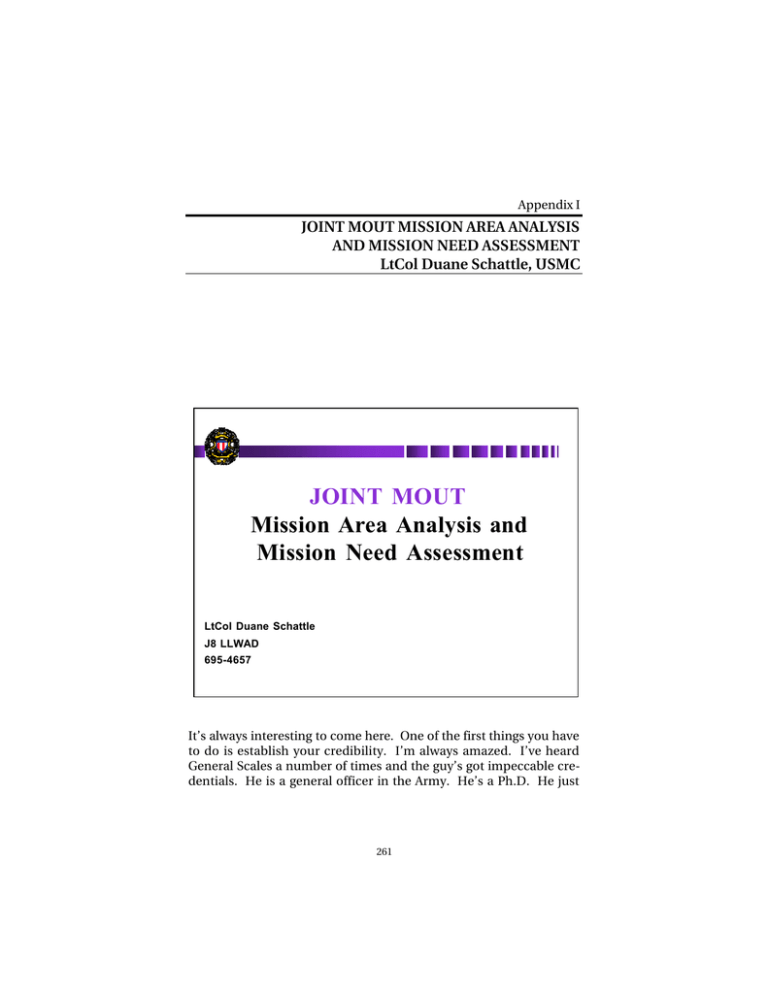
Appendix I JOINT MOUT MISSION AREA ANALYSIS AND MISSION NEED ASSESSMENT LtCol Duane Schattle, USMC J C HIE F S IO NT FF A OF S T JOINT MOUT Mission Area Analysis and Mission Need Assessment LtCol Duane Schattle J8 LLWAD 695-4657 It’s always interesting to come here. One of the first things you have to do is establish your credibility. I’m always amazed. I’ve heard General Scales a number of times and the guy’s got impeccable credentials. He is a general officer in the Army. He’s a Ph.D. He just 261 262 The City’s Many Faces commands respect immediately. Then you’ve got other guys like Dr. Andrews and of course Randy Steeb and his fourteen years of education. I had fourteen years of graduate education, too, and my parents were really glad when I finally got that high school diploma. One of the things I have to do is establish my credibility right up front because I’m wearing a Marine Corps uniform and I’m wearing a Joint Staff badge. A lot of people say, “you work in urban issues and that’s really the Commandant of the Marine Corps thing and you’re really probably a spokesman for the Commandant of the Marine Corps.” I have to tell you, it’s really not true. I really am a joint player. I really do believe in the joint world, and to establish that as fact I’ll tell you that my past goes way beyond my experiences in the Marine Corps. My dad was enlisted; he happened to have served in the Army, Navy, and the Air Force. He retired from the Air Force as an E-9 Chief. What has the Joint Staff done in the past? Where are we going in the future? How do we view this whole issue of urban operations? Joint MOUT Mission Area Analysis and Mission Need Assessment 263 JOINT MOUT STUDY A BIT OF HISTORY J OI N T C • H IE F S OF S F F TA LLW JWCA Review – Popular Literature (Kaplan,Keegan, Kennedy, Tofflers…) – United Nations - Habitat II & Cairo Conference – World Resources Institute - Urbanization Statistics & Models – RAND - Urbanization Warfare Studies (Taw, Hoffman, Davis) – Service School Studies – Chechnya-Professional Literature - Intelligence Data – Defense Science Board (86, 94 and 96) • MOUT ACTD (1997-2002) & Urban Warrior (1997-1999) – Grozny (95), Chairman’s (JCS) Concern – Joint Strategic Review (96) – MOUT Seminar Wargame (CSEEA) (96-97) – QDR (96-97) – Joint Staff Urban Capabilities Assessment (97) – Joint Warfighting Science and Technology Plan (98) I want to tell you right up front that we weren’t convinced that we needed to look at urban operations. So what we did was a front-end assessment to figure out if operations in cities are important. As General Scales mentioned yesterday, he’s very critical of people that say just because the world is urbanizing we’re going to go fight in the cities. I think that’s probably an appropriate conclusion; just because the world is increasingly urban doesn’t mean we’re going to fight in the cities. There’s got to be something else. So we looked at as much information as we could over a period of a year to establish whether or not this was a credible area for us to be concerned with. You can see some of the things that we looked at. Each one of these things involved lessons to be learned. 264 The City’s Many Faces JOINT MOUT STUDY Front End Assessment J OI N T C H IE F S OF S • F F TA Battles Examined (97) – Stalingrad (42-43), Manila (45), Seoul (50), Hue (68), Beirut (82), San Salvador (89), Panama City (89), Mogadishu (92-93) and Grozny (94-95) • Demographic Trends – UN: 45% urbanization today, 50% by 2005, 61% by 2025 – DIA: Urban Warfare asymmetric threats likely to US forces – JSR (96): there will be more urban terrain in 2010 – CPR (98): Doctrine of urban avoidance will not be possible • Political Landscape • Joint Vision 2010 • New Warfare Reality Strategy of Engagement – Collateral Damage – Casualty Aversion • CNN We examined nine separate battles picked because we wanted to determine some general trends. Why these battles? Well it’s because the people who did the study picked these, we approved them, and we wanted to see if there were any trends. Now the thing that came out of that study that was most alarming was the differences between what happened in Stalingrad in 1942 and 1943 and what happened in Grozny in 1994 and 1995. That really got my attention. When the Germans went into Stalingrad, millions of people died. And the Germans lost. Fifty years later, when the Russians went into Grozny, Chechnya, many attackers died and the Russians lost. Just like Stalingrad. The parallels between the things that happened in Stalingrad fifty years earlier and what happened in Grozny, even with all the technological innovations that the Russian Army had in 1995, were striking. We looked at the demographic trends, but we also looked at more than the demographics. We looked at the DIA assessment. We looked at the JSR, the national defense panel. We looked at the Defense Science Board and what they had to say. We looked at the Joint MOUT Mission Area Analysis and Mission Need Assessment 265 political landscape, including the fall of the Soviet Union and how things had changed. We looked at Joint Vision 2010. How are we going to do things differently and more efficiently in the 21st century? Then we looked at new warfighting realities. There are new realities that we have to be aware of, one of which is the collateral damage issue and casualty aversion. And casualty aversion is more than just concerns about friendly forces. It is also the noncombatant issue, and I think there is an argument that can be made after the highway of death incident during the desert war that we’re even averse to killing too many of the bad guys. It affects our policy. So those are the types of things that we included in our front-end assessment. And then, of course, there’s the CNN factor. We all know about the CNN factor. You’re going to see it unless the enemy kicks out the press, as was the case in Kosovo. You’re going to see live feeds as occurred during the Los Angeles riots with Reginald Denny, the guy who was dragged out of his truck. What kind of impact is that going to have? I suggest to you it’s going to be like instant replay in the NFL. The American populace is going to immediately judge the effects and the value of our policies based on what they see on television. We have to pay attention to that. So we’ve got to do things smarter and better. 266 The City’s Many Faces JOINT MOUT STUDY J OI N T C H IE F S OF S F F TA • Findings: – – – – Not All or Nothing Must maintain other capabilities Our Success has created the problem Need to address Joint Urban Operations Capabilities • Concerns: – Avoid and lay siege – Destroy and plunder – Sensors-R-US We have never said that this is an all-or-nothing approach. If you listen to some people, they would suggest to you we don’t need to invest money in urban operations; we don’t need look at these types of things because they take away from other needs. We’re suggesting that we take a balanced look at everything. We are in the cities already today; marines, soldiers, and airmen are operating in cities as we speak. It can be argued that our capabilities in open terrain have driven our enemies to the cities because they know they can’t compete with us on the outside. And that’s why a lot of these arguments about getting him before he gets to the city are great. If you can get him before he gets into the city, then good for you. But I think there are a couple of examples from the last ten years when we couldn’t get him before he got into the built-up area. In Desert Storm, we had intelligence that the Iraqis were massing at the border headed for Kuwait City. Now General Scales would suggest to you that in the Army After Next war game, the National Command Authorities waited too long to commit American forces to kill the enemy. My question to General Scales is, What’s new about that? We’re a representative democracy, and democracies don’t go to war quickly in Joint MOUT Mission Area Analysis and Mission Need Assessment 267 most cases. It takes time. It takes time to build coalitions. We tend to hesitate before risking involvement in long, drawn-out operations. It’s part of our way of doing business. But to suggest that the National Command Authorities are going to attack just because the generals say we should attack isn’t consistent with history. Kuwait is a perfect example. I suggest to you that this latest round in Kosovo is another good example. The enemy had forces in the immediate vicinity. The cities were very near by. How long does it take him to get from here to here, to move the people out, to take the cities, and how much force did we have to immediately influence what he can do? We didn’t have enough force. So again, General Scales’ argument, although it’s a good academic argument, flies in the face of reality. So, in our assessment we’ve said that we need to address the issues of urban conflict because we’re probably going to be involved there in the future just as we are today. The concerns that we have include possible approaches. These were answers given to me when we were doing this front-end assessment. First of all, we’re going to avoid fighting there. We’re going to go around or we’re going to lay siege to the city. But then when you ask the question: “Are you really going to lay siege to a city of a million people?” You’re going to starve out the bad guys? Well, are the bad guys going to let the civilians eat or are the bad guys going to eat? Who’s competing for food? Is the idea to set up camps where you can feed them? Are they going to let them go to those camps? And how are you going to feed a million people? Are we going to set up all the logistics first and then say, “Okay, here’s where the camps are,” and then send the military to protect the camps? By that time the enemy will be attacking those camps. I don’t follow that logic. That will not work. We’re not Alexander the Great, not Attila the Hun; we don’t fight war that way. We believe in just wars. Destroy and plunder is another approach. We’re going to line up our artillery; we’re going to line up our armor; we’ll put our tanks and everything else out there. We’re going to bomb the city into submission and then when we’re all done bombing we’re going to send the infantry in and let them clean it up. I think they tried that in Grozny. It didn’t work. They tried it in Stalingrad. It didn’t work. You are talking about linear combat, committing masses of divisions that the 268 The City’s Many Faces city will eat overnight. Is that what we want to do? And don’t forget CNN. They’re watching all this. And then there’s the Toys-R-Us option. We think we’re going to have all of these technologies and we’re going to throw them out there and we’re going to know everything. The next question is, “Then what?” Well, we know everything. We have perfect situational awareness. Do you still go in? If you don’t have the right capabilities to do something, you’re still stuck. We don’t want to end up in the 21st century doing what mankind has done throughout history. Joint MOUT Mission Area Analysis and Mission Need Assessment 269 J C HIE F S IO NT JOINT MOUT STUDY DESCRIPTION FF A OF S T • PURPOSE: Conduct a JROC & Defense-directed Joint Mission Area Operational Analysis and Joint Mission Need Assessment of U.S. Joint Warfighting Capabilitiesin the Urban Environment. • Defense Guidance – Continue studies to assess & explore Joint capabilities – Assess alternative approaches to conducting MOUT – Recommend actions to address doctrine – ID M&S & training requirements – ID requirements to achieve dominant MOUT • Include NLW • Build a roadmap to 2010 to find alternative approaches So what we did was convince the JROC that we wanted to take a look at this. The secretary quickly established this as a Defense study. The guidance was to accomplish the tasks shown above. 270 The City’s Many Faces JOINT MOUT STUDY JUWG Formed (1998) J OI N T C H IE F S OF S F F TA • OSD • State • CINCs • Services • Joint Staff • DOD Agencies – DIA, NIMA, NGIC, JWAC, NRO and ALSA • 90+ personnel (internet) • Weekly meetings • Monthly Offsite We formed a joint urban working group with members from OSD. We’re still working on the State Department; Ambassador Oakley has been involved because this issue is much broader than military only. It is an interagency process. That’s one of the problems we’re having; we can’t get the State Department formally involved. We’re going to continue to try to do that, but I’ve got to tell you it’s very difficult. You can see the other organizations that are involved. All the services have a speaking part, as do the CINCs. We meet weekly for about four hours to either bring in people to talk to us, take a look at technologies, or to discuss issues, then monthly we do the same types of things for an entire day. Joint MOUT Mission Area Analysis and Mission Need Assessment 271 J C HIE F S IO NT JOINT MOUT STUDY DESCRIPTION FF A OF S T • PHASE I (3 PARTS): – Assess the need for JointOperational MOUT Doctrine; – Conduct a survey ofAnalysis and Training M&S Tools for Joint MOUT operations; – Identify Joint Operational Mission Needsfor MOUT. The urban environment is not like the elephant with people trying to take one bite at a time. It’s more like a herd of elephants and they’re all running. The objective a year and a half ago was to slow them down and then get all the services and all the intellectuals involved in taking bites of these elephants so we can digest the subject over time. We identified these three areas that we thought were the most important. We wanted to take a look at the MOUT doctrine issue. We wanted to look at models and simulations, and we also wanted to look at mission needs for the joint force commander. The focus for us was at the operational level and joint force commander level rather than the tactical level. 272 The City’s Many Faces J C HIE F S PHASE I: JOINT MOUT DOCTRINE ASSESSMENT… COMPLETED IO NT FF A OF S T • Findings: – Current Doctrine Inadequate • Tactical, Ground-oriented, Linear and Attrition Driven • Not Joint, not Combined, nor Interagency • Operational Level Void – Needs • Joint Operational Doctrine • Joint Operational Concept • Short/Near-term Guidance Back in 1995 the Chairman of the Joint Chief of Staff, General Shalikashvili, turned to the Joint Staff after watching what had happened in Grozny and asked, “Do we need to pay attention to this? Do we need joint doctrine for MOUT?” The Joint Staff came back and said no, the Marines and the Army basically follow the same doctrine, and if we made a joint doctrine we’d just be taking what they’ve already said and putting it under another cover. Well, the problem is that Army and Marine doctrine isn’t joint. It doesn’t bring all the aerospace power and naval pieces together. We did an assessment. Ambassador Oakley was part of the team. We took former JTF commanders, including General Johnson from the Marine Corps, who was in the JTF in Beirut and in Somalia. Of course Ambassador Oakley was in Vietnam, Beirut, and Somalia. General Horner from the Air Force, General Otis, and General Downing, all retired generals, were asked these questions. Then we took it to the urban working group. We found that urban doctrine was tactical; it was groundoriented; it was linear; and it was attrition-based. It would lead us down the same path as the Russians followed in Grozny if we didn’t Joint MOUT Mission Area Analysis and Mission Need Assessment 273 do something. It wasn’t joint. It wasn’t combined. It wasn’t interagency. And there was a huge operational-level void. Putting it simply, the group agreed that we needed joint operational doctrine. We also needed an operational concept around which to build the doctrine, and we needed short-term guidance because writing the doctrine could take as long as two to three, maybe even four years. 274 The City’s Many Faces J C HIE F S IO NT PHASE I: JOINT MOUT DOCTRINE ASSESSMENT… COMPLETED FF A OF S T • Actions Taken (Urban Working Group Initiated): – JMOUT Doctrine (2001)... USMC Lead, USA Review Authority, J-8 Sponsorship – Ops Concept ...(w/Doctrine)...USMC Lead, UWG Guided – JTF Handbook (1999)... USAF Lead, UWG Guided The urban working group is the joint doctrine sponsor, with the Marines leading the writing effort and the Army acting as the reviewing authority. The operational concept was developed through a series of war games. The JTF handbook is being written by the Air Force to fill the void until the formal doctrine is completed. Joint MOUT Mission Area Analysis and Mission Need Assessment 275 J C HIE F S PHASE I: JOINT MOUT M&S ASSESSMENT…COMPLETED IO NT FF A OF S T • Findings: – JWARS and JSIMS will not address MOUT in near-term and long term is questionable – Training Tools… Appears Adequate But it Lacks Urban Terrain Data Bases – Analytic Tools Are Inadequate – Needs • Analytic Tools (Tactical and Operational) For: – Capability Assessments – Campaign Analysis – Rehearsal Tools • Terrain Data Bases for Both Analysis and Training Models and simulations. We found that it is very difficult to do anything other than qualitative analysis because, as has been mentioned by Randy Steeb, there’s really nothing out there for us to use. We found that out in the QDR. We can measure how B-2s and B-1s perform. There are models to do those types of things. When we got to the urban setting, what did we have to do? We had to sit around in a group and talk about it. That’s good, but it doesn’t carry the day when you talk about spending money in DoD. It doesn’t give you credibility. We found that nothing has changed in those 30 years. That ought to be alarming. It surely was to us. We found that a lot of people doing different types of things to make training realistic, but there is a serious database issue. We’ve got to address that. We need analytic tools. The few that are out there are not very good. We need to be able to do campaign analysis. We need to have rehearsal tools, just like for any other environment. And we need terrain databases for both analysis and training. 276 The City’s Many Faces J C HIE F S PHASE I: JOINT MOUT M&S ASSESSMENT…COMPLETED IO NT FF A OF S T • Actions Taken: – JCATS identified as possible short-term solution and long-term bridge; requires: • V&V (JWFC, $500K) • Identifying Acceptability Criteria... What Should Model Do (UWG Can Help) • Terrain Data Bases (larger than normal data requirement) • FY 2001-2005 Defense Language (Apr 99) states: “Critical to this effort, the Department, through the Joint Staff, must develop short-term analytic tools to assess those capabilities.” Then we stumbled on JCATS. Although it’s not the panacea, it is, in our judgment, the answer in the short term. We found that JCATS has a lot of the things that allow it to be that link between present and future capabilities. We’d have to identify the JCATS acceptability criteria operational level, and then each of the services could do whatever they think is necessary. All the services are using JCATS right now, but the back of a terrain database keeps coming back to haunt us. We need quantitative analysis. Joint MOUT Mission Area Analysis and Mission Need Assessment 277 J C HIE F S IO NT PHASE I: JOINT MOUT MISSION NEEDS COMPLETE FF A OF S T • Findings: – C4 and ISR require independent detailed assessment now – Lack of M&S tools makes assessments difficult and leads to qualitative not quantitative results – Because of closed terrain and population, etc., often tactical concerns become operational issues – No centralized focus to address Joint Requirements – Much more needs to be done... (Phase II & III address) – Current study identified 108 Candidate Mission Needs The third piece was mission needs at the joint force level. We immediately identified that we were not going to be able to address certain things. We knew that we needed a C4 and an ISR study and thus initially chose to focus on just those two areas. These were not decisions that are made just because somebody in our shop thought it was important. The Urban Working Group came up with these recommendations. The J6 is doing the command and control part of the study. It’s ongoing right now with help from the Decision Support Center, which works directly for the Vice Chairman. And the J2P is doing the ISR piece. Another thing we found out was that the lack of models and simulations make these studies difficult. We’re trying to do a work-around with OPNET, JCATS, and other models, but it’s very difficult to do. It just reinforces the fact that we need help in the simulations area. Another one of our findings as we looked at joint mission needs was that closed terrain often causes tactical issues to become operational concerns. That may not sound like a very big deal to you, but it is a 278 The City’s Many Faces huge deal when we talk about work on the Joint Staff that starts getting into the service arenas. The lines between tactical, operational, and strategic are beginning to blur. Let me give you a couple of examples. Normally you would think body armor is a tactical concern. That’s an issue for the individual on the ground. And it is an issue for the individual on the ground. But if you don’t look at it from the joint perspective, this is what you end up with. The joint force commander has to operate in an urban environment with two types of ground force—let’s say the Marines and the Army. He’s got to employ ground forces in a high-risk situation. The National Command Authorities then say, “We’re really concerned about force protection issues. I want to make sure those guys have the most protection as possible.” Then somebody comes to him and says, “Well, general, the Army guys have level 3 body armor, the Marines only have flak jackets.” You think that’s a tactical concern for the JTF commander? I submit to you that it’s not. Here’s another example: combat identification. Combat ID is normally a tactical concern; we’re not too concerned about that at the JTF commander’s level, right? I guarantee you it’s a concern for the JTF commander, especially when you’re in a city where you can’t see 15 feet around a corner and friendly force casualties could cause mission failure. That’s what we’re talking about. A lot of these things have operational impact, and it’s important to note that. We also found that there’s no centralized focus for addressing these joint requirements; people are working things on their own. We also found that we’re only scraping the tip of the iceberg right now and there’s a lot more that needs to be done. What we’ve done is lay out a plan to try and address those needs. Joint MOUT Mission Area Analysis and Mission Need Assessment 279 J C HIE F S PHASE I: JOINT MOUT MISSION NEEDS COMPLETE IO NT FF A OF S T • Actions Taken: – UWG Narrowed 108 Needs to Top18 Communications Precision effects Knowledge of cities Threat detection/ neutralization JTF single common picture Information control Precision navigation CID CSAR in urban Rapid & responsive firepower Population control Mobility Consequence management Medical Logistics Training Training analysis Campaign analysis There are the top 18 identified needs that are to be addressed in a phase 1 study. Some of them look very familiar to you. What we’re going to do is take a look at existing mission needs statements and see which of these areas are covered for the urban environment. For those that are not, we’ll make recommendations to the JROC and the DPAG regarding possible solutions. We ought to finish these 18 off in the next three or four months, then go back to the JROC and tell them we’ll start going after those remaining out of the 108. 280 The City’s Many Faces J C HIE F S PHASE I: JOINT MOUT MISSION NEEDS (ACTIONS TAKEN, CONT’D) IO NT FF A OF S T • Phase II Tasks Identified: – Follow-on Mission Needs… • Refine and prioritize Candidate Mission Needs/forward to JROC • Input C4 (J-6/DSC) and ISR (J2/DSC) Study Mission Needs – Transition Study...Develop • Concept Exploration/Roadmap • Institutionalization of Joint Mission Needs Options • MOUT Oversight Options – Address Terrain Data Base Issues • Prioritization • Sponsorship • Funding, etc. – Address Future Joint and Service Studies These are the things we are doing in phase 2 for this fiscal year. We will refine those 18 and take a look at what comes out of the C4 and the ISR studies. We’ll add them to this as we take it forward and rebrief it. We’re also doing what’s called a transition piece. We’ve been directed by the secretary to build a science and technologies roadmap out to the year 2010 to bring all of these concepts together. We will then have a vision of what the future’s going to be and what our experimentation plan will be. We’re going to look at how we institutionalize joint mission needs and joint requirements. And then we’re going to provide options to the secretary and JROC on how to best manage this. Should it go to ACOM? When should they get it? In the meantime, what do we do? Do we give it to a service? Should it be a joint program office? We want to answer those questions and provide options so the decisions can be made. We’re also going to address the terrain database issue. Now, we’re not going to do an in-depth study in the terrain database, but the urban working group will address things like prioritization. If we’re going to build terrain databases we have to establish priorities. Is it Joint MOUT Mission Area Analysis and Mission Need Assessment 281 going to be large cities, small cities? Is it going to be five different cities so that you can do some type of assessments? These are not trivial questions. We are talking about C4ISR capabilities in cities. Take New York City for example. We can build a terrain database of New York City, but New York City is flat. It’s got a lot of high-rises, but it’s flat. You go to San Francisco, a lot of high-rises, and it’s on hills. Most places in the world don’t have all those high-rises. So we have to make some choices here because there’s only so much money available. We’re also going to address the future of joint and service studies, to establish what is it that each of the services feels that they should be doing in this environment. We’ll then attempt to get them to sign up for that. 282 The City’s Many Faces J C HIE F S IO NT PHASE I: JOINT MOUT MISSION NEEDS (ACTIONS TAKEN CONT’D) FF A OF S T • Phase III Assessment Priorities Identified: – JMOUT Training and Facilities – Urban Information Architecture – JMOUT Center of Excellence/Analysis – Future Joint and Service Studies (Precision Effects, Combined Arms, Strike, Airpower, Artillery, Information Systems, RW, Armor, Space, Logistics, etc.) – Data Base Study – Others as Identified... That was phase 2. That’s where we are now. Phase 3 is for next year. At the very top of the list you see joint MOUT training and facilities. It’s a huge issue. We just briefed the JRB and recommended that they support accelerating this study. It was approved by the JRB. I assume it will be approved by the JROC and the CINCs and we’ll start down this road in the next three or four months. What are we looking at? We don’t have places to train. I know that the Marines did the best they could, had the mayor agree that they would be able to land across the beach in Monterey, but they didn’t get to make the amphibious landing. The same thing happened in San Francisco. This is a huge problem. What we don’t want is to have the services stepping out on their own and building millions of dollars worth of small MOUT facilities with no strategic plan. We’ll approach this issue the same way we approached the others. What are the requirements for urban training and training facilities? What do we have now, and what’s the gap? We will provide options. Do we need a national training center for urban operations; a huge city built in the desert? How much is that going to cost? And how many people Joint MOUT Mission Area Analysis and Mission Need Assessment 283 are going to use it? Do we need to expand the JRTC? Is that a better option? What are the best options to meet the requirements? You can see the other areas we’re going to look at next year. 284 The City’s Many Faces J C HIE F S IO NT JOINT MOUT MISSION NEEDS PHASE I …..COMPLETE FF A OF S T • Reoccurring Themes – Joint capabilities required (ISR, C4, CAS, etc.) – The city is more than an environment, it is a living entity – The lack of analytic tools makes quantitative MOUT analysis almost impossible – In urban areas the distinction between tactical and operational concerns is often unclear – There is a need for a single focal point to address MOUT – The term MOUT inhibits progress – Much more needs to be done to address Joint MOUT capabilities and needs These are the recurring themes that keep coming back to haunt us. Joint capabilities is a joint fight. It’s not a single service fight. It’s not a land fight. It’s not an air fight. It’s a joint fight. It’s interagencies. The city is more than an environment. It includes the most difficult environment because of the three-dimensional issues. But the real factors that make it different are the civilians in that city, and the infrastructure that ties it together. It is more than just an environment. The urban working group likes to compare the city to a living organism. In order to operate successfully, and remember we’re not just talking about fighting, a force must remove the cancer without killing the patient. But there is a time issue. You can’t let the cancer grow to the point where it is so advanced that the patient’s going to die anyway. In addition, you’ve got to make sure you’re cutting the cancer, that you don’t make a mistake and cut off the wrong part. If you’re doing brain surgery, make sure you do the right part of the brain so you don’t unnecessarily affect other parts of the body. The term “MOUT” itself inhibits progress. Why? What is MOUT? I bet that 80 percent of you would say, “That’s marines and soldiers on Joint MOUT Mission Area Analysis and Mission Need Assessment 285 the ground fighting.” But that’s not the definition of MOUT. Mark Sumner pointed out yesterday that the Army and Marine Corps have basically the same definition. It’s much broader than combat only. It’s all operations in built-up areas. So the urban working group has decided it is not going to refer to the term “MOUT” in the future. We’re going to use the term “urban operations.” 286 The City’s Many Faces J C HIE F S IO NT DOD MOUT - INCREASED INTEREST FF A OF S T USMC UWG -Urban Warrior -Urban CAS -MOUT ACTD SOCOM UWG -Wargame -MOUT ACTD USA MOUT Task Force - MOUT ACTD - Mounted Battlelab - Dismounted Battlelab -JRTC MOUT Exercises AAN 2025+ -LIA UWG -Army S&MDC USN -Fleet Battle Exercise 2 -C2 Afloat -Precision Effects Experimentation -DARPA SUO -NLW -CID Joint Staff UWG -JWCA Reps -DPG Studies USAF -MCDW -CAS ACOM -J9 -JWFC -Homeland Defense OSD DIA ALSA JWAC Conferences -MIT Briefing -NSSG -NDIA/ASD (SO/LIC) -Hurlburt, USAF -Maxwell, USAF -RAND -AWC Brief -AWC Study Group The reason I put on this slide is to show you all the things that are going on in the urban area now; there are probably some things missing. Two years ago there were really only two initiatives ongoing: the MOUT ACTD and Urban Warrior. There were some RMA net assessment games that were tied to those two. Since then, you can see all these other things that have begun: the use of minimal collateral damage weapons, various studies, Army After Next urban initiative conferences; all of these types of things are now ongoing. And the urban working group is a key part of that growth.
